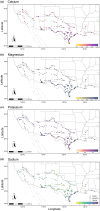Contrasts among cationic phytochemical landscapes in the southern United States
- PMID: 37283990
- PMCID: PMC10168053
- DOI: 10.1002/pei3.10093
Contrasts among cationic phytochemical landscapes in the southern United States
Abstract
Understanding the phytochemical landscapes of essential and nonessential chemical elements to plants provides an opportunity to better link biogeochemical cycles to trophic ecology. We investigated the formation and regulation of the cationic phytochemical landscapes of four key elements for biota: Ca, Mg, K, and Na. We collected aboveground tissues of plants in Atriplex, Helianthus, and Opuntia and adjacent soils from 51, 131, and 83 sites, respectively, across the southern United States. We determined the spatial variability of these cations in plants and soils. Also, we quantified the homeostasis coefficient for each cation and genus combination, by using mixed-effect models, with spatially correlated random effects. Additionally, using random forest models, we modeled the influence of bioclimatic, soil, and spatial variables on plant cationic concentrations. Sodium variability and spatial autocorrelation were considerably greater than for Ca, Mg, or K. Calcium, Mg, and K exhibited strongly homeostatic patterns, in striking contrast to non-homeostatic Na. Even so, climatic and soil variables explained a large proportion of plants' cationic concentrations. Essential elements (Ca, Mg, and K) appeared to be homeostatically regulated, which contrasted sharply with Na, a nonessential element for most plants. In addition, we provide evidence for the No-Escape-from-Sodium hypothesis in real-world ecosystems, indicating that plant Na concentrations tend to increase as substrate Na levels increase.
Keywords: Random Forest; calcium; homeostasis; magnesium; potassium; sodium; spatial autocorrelation.
© 2022 The Authors. Plant‐Environment Interactions published by New Phytologist Foundation and John Wiley & Sons Ltd.
Conflict of interest statement
The authors declare no conflict of interest.
Figures







Similar articles
-
Roles and Transport of Sodium and Potassium in Plants.Met Ions Life Sci. 2016;16:291-324. doi: 10.1007/978-3-319-21756-7_9. Met Ions Life Sci. 2016. PMID: 26860305
-
Selectivity coefficients of K, Na, Ca, and Mg in binary exchange systems in some calcareous soils.Environ Monit Assess. 2020 Jan 2;192(2):80. doi: 10.1007/s10661-019-8022-y. Environ Monit Assess. 2020. PMID: 31897755
-
Soil, climate, and landscape drivers of base cation concentrations in green stormwater infrastructure soils.Sci Total Environ. 2024 Mar 1;914:169907. doi: 10.1016/j.scitotenv.2024.169907. Epub 2024 Jan 5. Sci Total Environ. 2024. PMID: 38185164
-
Transport, signaling, and homeostasis of potassium and sodium in plants.J Integr Plant Biol. 2014 Mar;56(3):231-49. doi: 10.1111/jipb.12159. J Integr Plant Biol. 2014. PMID: 24393374 Review.
-
Patterns in potassium dynamics in forest ecosystems.Ecol Lett. 2006 Apr;9(4):451-66. doi: 10.1111/j.1461-0248.2006.00891.x. Ecol Lett. 2006. PMID: 16623731 Review.
Cited by
-
Low sodium availability in hydroponically manipulated host plants promotes cannibalism in a lepidopteran herbivore.Sci Rep. 2023 Nov 27;13(1):20822. doi: 10.1038/s41598-023-48000-z. Sci Rep. 2023. PMID: 38012267 Free PMC article.
References
-
- Adams, D. K. , & Comrie, A. C. (1997). The North American monsoon. Bulletin of the American Meteorological Society, 78, 2197–2213.
-
- Alemán, F. , Nieves‐Cordones, M. , Martínez, V. , & Rubio, F. (2009). Potassium/sodium steady‐state homeostasis in Thellungiella halophila and Arabidopsis thaliana under long‐term salinity conditions. Plant Science, 176, 768–774.
-
- Apse, M. P. , Aharon, G. S. , Snedden, W. A. , & Blumwald, E. (1999). Salt tolerance conferred by overexpression of a vacuolar Na+/H+ Antiport in Arabidopsis . Science, 285, 1256–1258. - PubMed
-
- Apse, M. P. , & Blumwald, E. (2007). Na+ transport in plants. FEBS Letters, 581, 2247–2254. - PubMed
-
- Austin, A. T. , & Zanne, A. E. (2015). Whether in life or in death: Fresh perspectives on how plants affect biogeochemical cycling. Journal of Ecology, 103, 1367–1371.
Associated data
LinkOut - more resources
Full Text Sources
